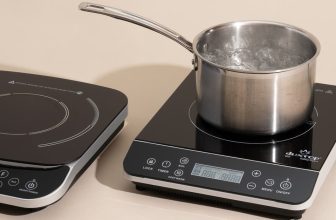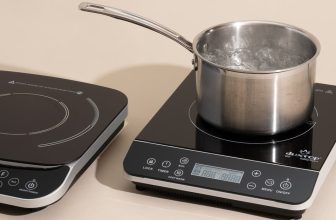As an Amazon Associate I earn from qualifying purchases.
Are Induction Cooktops Worth The Extra Money?
Are Induction Cooktops Worth The Extra Money? Induction cooktops, with their sleek design and fast heating times, have been capturing the attention of culinary experts worldwide. Considering that they can boil water up to 50% faster than traditional gas or electric setups, it raises an interesting question about their worthiness. This efficiency isn’t just about speed—it translates into energy savings and precision cooking, attributes highly valued in professional kitchens.
Historically, induction cooktops were a rarity, mainly due to high costs and limited consumer awareness. However, advancements have made them more accessible and economically viable. A compelling statistic reveals that induction cooktops are now 84% energy-efficient compared to electric coils at 74% and gas at 40%. This efficiency, alongside improved safety features and ease of cleaning, showcases why many experts deem them a worthy investment.

Are Induction Cooktops Worth the Extra Money?
Induction cooktops use electromagnetic energy to heat pots and pans directly. This method is faster and more efficient than traditional gas or electric cooktops. One of the main advantages is how quickly they can boil water or cook food, potentially saving time in the kitchen. Professional chefs often praise them for their precise temperature control. This precision can be crucial for delicate dishes or techniques.
Another strong point for induction cooktops is their energy efficiency. Induction cooking transfers energy directly to the pot, reducing wasted heat. This can be both environmentally friendly and cost-effective in the long run. Compared to gas or electric cooktops, induction models often use less energy. A table comparing energy efficiency clearly shows this benefit:
| Cooktop Type | Energy Efficiency |
|---|---|
| Gas | 40% |
| Electric Coil | 74% |
| Induction | 84% |
Despite the benefits, induction cooktops do have drawbacks. They typically cost more upfront than other types of cooktops. Not all cookware is compatible with induction cooking, so there might be an added expense to replace pots and pans. Additionally, the initial cost can be a barrier for some households.
When considering whether induction cooktops are worth the extra money, you must weigh the pros and cons. Their higher efficiency and faster cooking times are appealing. Yet, the initial investment and potential need for new cookware should be considered. Ultimately, the decision depends on individual needs and cooking preferences.
Understanding the Mechanics of Induction Cooktops
Induction cooktops work differently than gas or electric stoves. They use electromagnetic fields to transfer heat directly to the cookware. This means the cooktop itself stays relatively cool. That’s why induction cooking is both safe and efficient. This process all starts with a coil beneath the cooking surface.
The coil generates a magnetic field when turned on. For the pan to heat up, it must be made of a magnetic material like cast iron or certain stainless steels. The magnetic field induces electric currents in the cookware, causing it to heat up. This method is incredibly precise, offering better temperature control than traditional stoves. The heat is produced where it’s needed most—inside the pot or pan.
One of the biggest benefits of using induction is its energy efficiency. Unlike gas or electric cooktops, only the cookware gets hot. This reduces wasted heat and makes cooking more comfortable. For example, boiling water can be significantly faster. Many users find this feature saves them both time and energy.
However, not all pots and pans will work with induction cooktops. You need cookware that is ferromagnetic, meaning it has a magnetic bottom. A simple test is to see if a magnet sticks to the bottom of your pan. If it does, you’re good to go. This can be a deciding factor when choosing induction over other types of cooktops.
The Upside: Advantages of Induction Cooktops
One of the standout advantages of induction cooktops is their speed. They heat up faster than traditional gas or electric stoves. This is because the heat is transferred directly to the cookware. Boiling water or cooking meals takes less time. This can be a huge benefit for busy households.
Another major perk is the energy efficiency of induction cooktops. They use less energy by focusing heat directly on the pan rather than the surrounding area. This means less wasted energy and lower utility bills. Additionally, this efficient heating method can make the kitchen feel cooler. It reduces the amount of heat released into the air.
Safety is also a significant advantage. Since the cooktop surface stays cooler, there’s less risk of burns. When you remove a pot, the cooktop cools down quickly. This feature is particularly useful in households with children. The safety aspect extends to automatic shut-offs as well.
Clean-up is simpler with induction cooktops. Spills and splatters don’t burn onto the cooktop. You can wipe them away easily since the surface stays cool. This benefit saves time and effort in maintaining a clean kitchen. Additionally, the sleek design of induction cooktops adds a modern touch to any kitchen.
The Downside: Drawbacks of Induction Cooktops
One of the main drawbacks of induction cooktops is their cost. They generally have a higher upfront price compared to gas or electric stoves. This can be a significant barrier for many households. Additionally, the cost doesn’t stop with the cooktop itself. You may need to invest in compatible cookware.
Speaking of cookware, not all pots and pans work with induction cooktops. You need items made of magnetic materials like cast iron or certain types of stainless steel. This requirement can limit your choices and add to your expenses. Checking your existing cookware with a simple magnet test can help. If a magnet sticks to the bottom, it’s compatible.
Another issue is the noise that induction cooktops can make. When in use, these cooktops can produce a humming or buzzing sound. This noise comes from the electromagnetic energy interacting with the cookware. For some, this could be an annoying feature. It’s a small drawback but worth mentioning.
Installation of induction cooktops can also be tricky. They often require a specific type of electrical outlet, which might involve additional installation costs. This means you might need a professional to set it up properly. On top of that, if you live in a place with inconsistent power supply, it could affect your cooking experience.
Finally, even though induction cooktops cool down quickly, the rapid temperature change can be an issue. Some may find the instant heat adjustments challenging to handle, especially when cooking dishes requiring gradual heating. This could be particularly problematic for novice cooks. Transitioning from gas or electric to induction might take some getting used to.
Economic Considerations and Energy Efficiency
When considering induction cooktops, the initial cost can be a major factor. These cooktops are generally more expensive than gas or electric ones. The price can range from a few hundred to over a thousand dollars. However, the long-term savings in energy costs can offset this initial investment. This makes them a worthwhile consideration for many households.
Energy efficiency is a notable strength of induction cooktops. They transfer energy directly to the cookware, meaning less energy is wasted. Traditional gas and electric stoves lose a lot of heat to the surroundings. Induction cooktops, on the other hand, keep the kitchen cooler and use less power. A comparison of energy efficiency highlights this advantage:
| Cooktop Type | Energy Efficiency |
|---|---|
| Gas | 40% |
| Electric Coil | 74% |
| Induction | 84% |
Another economic benefit is the reduced cooking time. Induction cooktops can boil water or cook meals much faster. This saves both time and energy. Over time, these savings can add up, making your household more energy-efficient. Moreover, quicker cooking means less energy spent heating up the kitchen, which can reduce cooling costs in warmer months.
Maintenance and lifespan also play a role in the economic considerations. Induction cooktops have fewer parts that can wear out over time. This can translate to lower maintenance costs compared to gas stoves, which require regular cleaning and upkeep. Additionally, the smooth surface makes cleaning easier, saving you time and effort. Long-term durability can make the initial investment more justifiable.
However, don’t forget the additional costs of compatible cookware. Not all existing pots and pans will work with induction. If you need to buy new cookware, this is an added expense to keep in mind. But the combined benefits in energy efficiency and lower maintenance can still make induction cooktops an economically sound choice.
Frequently Asked Questions
Induction cooktops are gaining popularity due to their efficiency and modern features. Below are some common questions to help you understand if they are the right fit for your kitchen.
1. How do induction cooktops work?
Induction cooktops use electromagnetic fields to generate heat directly in the cookware. Unlike traditional methods, the cooktop itself remains relatively cool. This transfer of energy is highly efficient and fast, making it ideal for quick cooking tasks.
The process starts when a magnetic coil beneath the surface creates an electromagnetic field. For this to work effectively, you need cookware made from magnetic materials like cast iron or certain stainless steels.
2. What are the benefits of using induction cooktops?
Induction cooktops offer numerous benefits, such as faster cooking times and improved energy efficiency. They also provide precise temperature control, which is crucial for dishes requiring exact heat settings.
The surface of induction cooktops stays cool to touch, reducing the risk of burns and spills. This makes them safer for households with children or busy kitchens where accidents can happen easily.
3. Are there any drawbacks to induction cooktops?
The primary drawback is the higher upfront cost compared to gas or electric stoves. Additionally, not all existing cookware will work with induction technology, possibly requiring new investments in compatible pots and pans.
Another potential issue is the noise; these cooktops can produce a slight humming sound during operation. Some users find this annoying, although it’s generally considered a minor inconvenience compared to the benefits offered.
4. Can I install an induction cooktop myself?
While some models might be easy enough for DIY installation, many require professional setup due to specific electrical requirements. It’s essential that your home wiring supports the necessary voltage and amperage.
If you’re unsure about handling electrical installations, it’s best to hire a qualified electrician. This ensures safety and proper functioning of your new appliance without any risks associated with incorrect installation.
5. How do I know if my cookware is compatible with an induction cooktop?
A simple way to check compatibility is by using a magnet on the bottom of your cookware. If it sticks firmly, then your pot or pan should work on an induction cooktop.
You can also look for labels indicating “induction compatible” when purchasing new cookware sets. Brands often specify this feature prominently so consumers can make informed decisions easily while shopping.
Conclusion
Induction cooktops offer a range of benefits, such as energy efficiency, faster cooking times, and precise temperature control. They are an excellent choice for modern kitchens and professional chefs alike. However, their higher initial cost and the need for compatible cookware can be drawbacks that require consideration.
Weighing the pros and cons will help determine if an induction cooktop is a worthwhile investment for you. If speed, efficiency, and safety are high priorities, induction technology may be the right choice. Ultimately, your decision depends on your specific needs and budget.






